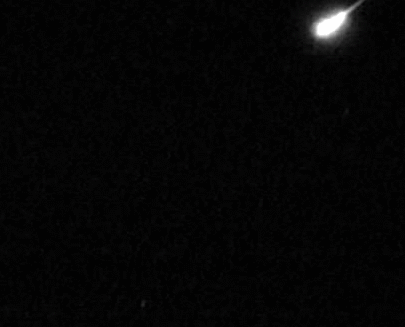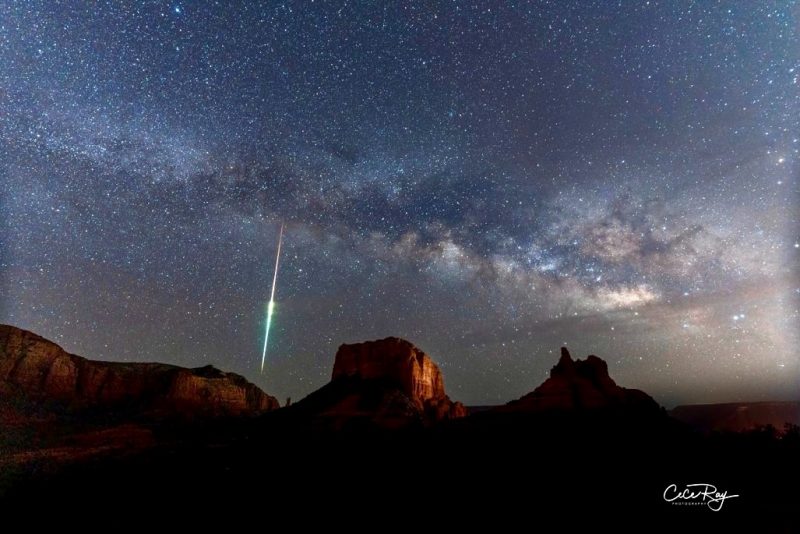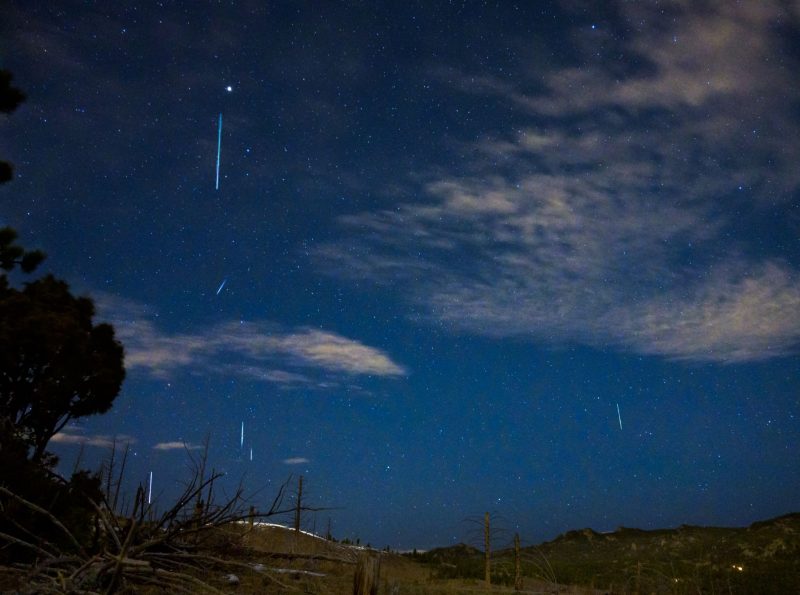The annual Lyrid meteor shower brings an end to the annual meteor “drought” that happens each year between early January and late April.
When to watch in 2024: Late evening April 21 until dawn April 22 is the shower’s likely peak. The predicted** peak is 9:23 UTC on April 22. The peak of the Lyrids is narrow (no weeks-long stretches of meteor-watching, as with some showers). And, in 2024, the full moon will fall at 23:49 UTC on April 23. So your Lyrid meteor watching will be in moonlight this year. Tip: Go to a country location where the skies are as dark and clear as possible. Observe under a wide-open sky. But try to place yourself in a moon shadow. If you can block out the sight of the moon, yet still have some sky left for seeing meteors, you might see some of the brightest Lyrids blaze past in the bright moonlight. Remember, even one bright meteor can make your night!
Radiant: Rises before midnight, highest in the sky at dawn.
Nearest moon phase: Full moon falls at 23:49 UTC on April 23. So a bright waxing gibbous moon will be in the sky during the peak morning for 2024’s Lyrid meteor shower.
Duration of shower: April 15 to April 29. But the shower is strongest, by far, near its peak.
Expected meteors at peak, under ideal conditions: In a dark sky with no moon, you might see 10 to 15 Lyrids per hour. You won’t see that many in 2024 due to the bright moon. Still, the Lyrids are known for uncommon surges that can sometimes bring rates of up to 100 per hour! Read more about Lyrid outbursts below.
Note for Southern Hemisphere: This shower’s radiant point is far to the north on your sky’s dome. So the Southern Hemisphere will see fewer Lyrid meteors. Still, you might see some!
Meteor train possibilities? In a moonless sky, about a quarter of Lyrid meteors leave persistent trains. That is, they leave a trail of ionized gases that glow for a few seconds after the meteor has passed. In the bright moonlight in 2024, you likely won’t spot many (if any) meteor trains.
Read more: Meteors in moonlight: 6 tips for 2024’s Lyrids
Report a fireball (very bright meteor) to the American Meteor Society: it’s fun and easy!
The Lyrid meteor shower parent comet
From the late, great Don Machholz (1952-2022), who discovered 12 comets …
Most meteor showers are caused by debris from a passing comet. For the Lyrids, the comet is named Comet Thatcher. Maybe you’re wondering: Have I ever observed Comet Thatcher? The answer is no. And your children won’t see it either.
Astronomers first noticed this comet in 1861, around the time of its last perihelion, or closest point to the sun. It takes roughly 415 years to go around the sun once. Its path brings it within the Earth’s orbit, then it goes really far away, a distance of about 110 astronomical units (AU). That’s 110 times farther from the sun than we are.
So Comet Thatcher is now far away, still traveling outward, away from our sun. It’ll reach its farthest point from the sun around the year 2070, and then begin its return trip to reach its next perihelion around year 2283.
The Lyrid meteor shower – spawned by this comet – seems to outburst, or produce an unexpectedly large number of meteors, every 60 years. The next Lyrid outburst is due in 2042. The outbursts happen because of the planets’ reshaping the long trail of comet debris left behind by Comet Thatcher in its long orbit. This debris is what intercepts Earth’s orbit yearly to create the meteor shower.
Discovery of Comet Thatcher
Alfred E. Thatcher from New York City discovered this comet – now officially C/1861 G1 (Thatcher) – on April 5, 1861. At that time the comet was in the direction of our sky’s north polar region, toward what we see as the constellation Draco. Alfred Thatcher was using a 4.5-inch-diameter (11cm) refracting telescope, magnifying 30 times. The comet was shining at magnitude 7.5, fainter than the unaided eye can see.
But over the next few weeks, as the comet approached both the sun and the Earth, it brightened considerably. It became visible to the eye and remained so until it disappeared into the evening twilight in early June 1861. Observers in the Southern Hemisphere picked it up in late July and followed the comet for the next five weeks, until it became too faint to see from anywhere on Earth.
Comet Thatcher will be back in the year 2278. But its debris trail, the Lyrid meteor shower, will be here every April.
How to find the Lyrid meteor shower radiant point
From the Northern Hemisphere. the bright star Vega in the constellation Lyra – near the radiant point for the Lyrid shower – rises above your local horizon, in the northeast, around 9 to 10 p.m. your local time in April. That’s the time on your clock, from mid-latitudes, from the northern part of the globe. Vega climbs upward through the rest of the night. By midnight, Vega is high enough in the sky that meteors radiating from that direction streak across your sky. Just before dawn, Vega and the radiant point shine high overhead, and the meteors will be raining down from the top of the Northern Hemisphere sky.
From the far southerly Southern Hemisphere. Vega – and the Lyrid meteors’ radiant point – don’t rise until the hours before dawn from the southern mid-latitudes. From there, the radiant point never gets very high in the sky. Many of the meteors that come from this point head northward, below your horizon if you’re in the Southern Hemisphere. Thus, you have a narrower window for watching this particular, far-northern shower. Still, you might see some meteors!
The higher Vega appears in your sky, the more meteors you’re likely to see.
Lyrid meteors and Earth, from space
On the night of April 21, 2012, the Lyrid meteor shower peaked in the skies over Earth. Astronaut Don Pettit aboard the International Space Station trained his camera on Earth. Video footage from that night can be seen in the video below. The bright points of light are the meteors ablating – or burning up – in Earth’s atmosphere.
Video via NASA.
Lyrid meteor shower in history
The Lyrid meteor shower has the distinction of being among the oldest of known meteor showers. Records of this shower go back for some 2,700 years. The ancient Chinese seem to have observed the Lyrid meteors falling like rain in the year 687 BCE. That time period in ancient China, by the way, corresponds with what is called the Spring and Autumn Period (about 771 to 476 BCE), which tradition associates with the Chinese teacher and philosopher Confucius, one of the first to espouse the principle:
Do not do to others what you do not want done to yourself.
Lyrid meteor photos from the EarthSky community
Submit your night sky photos to EarthSky here
Bottom line: Best time to watch the Lyrid meteor shower: before dawn on the morning of April 22, 2024. Sure, there’s a bright moon out there. But you might see some!
**Predicted peak times and dates meteor showers are from the American Meteor Society. Note that meteor shower peak times can vary. Back to top




















